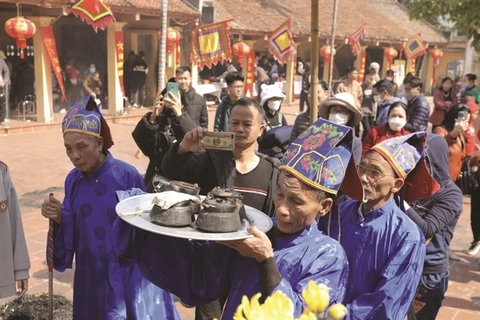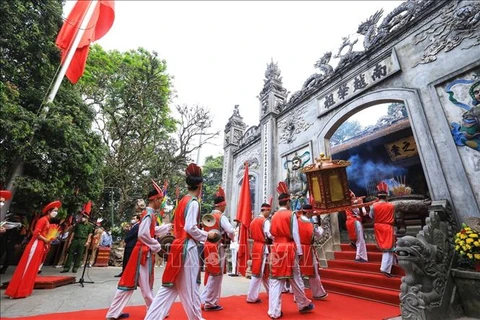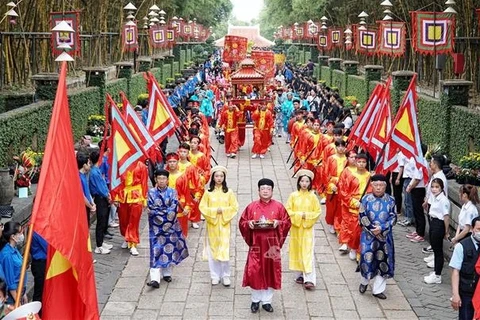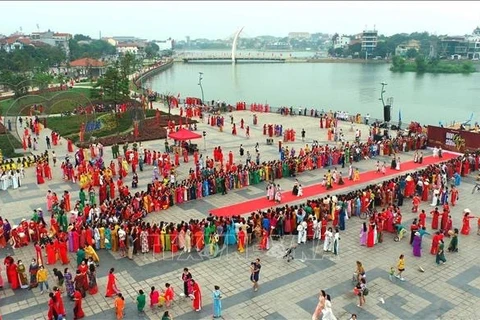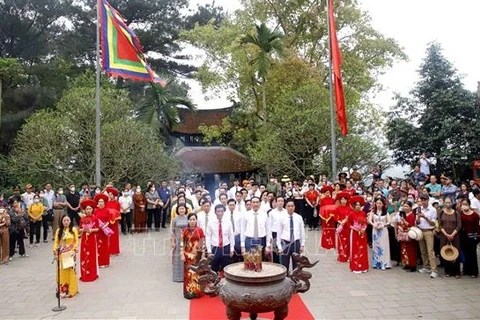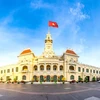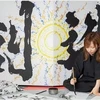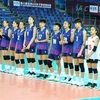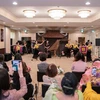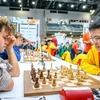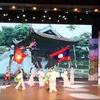 People go to Hung Kings temple on the occasion of a festival that mark the death anniversary of Hung Kings. (Photo: VietnamPlus)
People go to Hung Kings temple on the occasion of a festival that mark the death anniversary of Hung Kings. (Photo: VietnamPlus) Phu Tho (VNA) – The Hung Kings Temple historical relic site located in Co Tich hamlet, Hy Cuong commune, Viet Tri city, the northen midland province of Phu Tho, is a place to worship the Hung Kings, the legendary founders of the nation.
In the old days, this land was the centre of Van Lang’s capital lying between two rivers that served to protect the former capital. There were many rivers, lakes, hills, and fertile fields adjacent to the two rivers, which were favourable for livelihoods, and defence.
Currently, traces of inhabitants residing in the Hung Kings dynasty were found in dozens of archaeological sites, densely distributed from the Lam Thao district to the Bach Hac – Viet Tri confluence.
Such archaeological relics are evidence of an age of a copper metallurgy industry and wet rice cultivation as part of an agricultural civilisation that existed for thousands of years B.C.
The Hung Kings Temple, 80km north west of Hanoi, is a Special National Historical Relic. Temples dedicated to Hung Kings are located on Hung Mountain (also known as Ca mountain by locals. It is also known as the Nghia Linh mountain or Hy Cuong mountain) at an elevation of 175m above sea level. Today the Hung mountain is still a natural forest with different generations of trees including 150 species of plants belonging to 35 families, such as Banyan, Pine, Cycad, and the Parashorea tree.
The 850ha complex consists of four temples, one pagoda, a tomb, and a museum featuring the formation and development of Van Lang.
The upper, middle, and lower temples commemorate the 18 Hung Kings. The fourth worships two daughters of the 18th Hung King: princesses Tien Dung and Ngoc Hoa.
The 8.5m entrance arch has eight tiled roofs engraved with dragons and lion cubs. In the front are embossments of two soldiers wearing amor, one carrying a spear and one carrying an axe.
Up the mountain from the entrance arch the Ha (lower) Temple where there are three thrones and tablets to worship all 18 Hung Kings. The temple is associated with the legendary story about the origin of Vietnamese people. Legend has it that Lac Long Quan (real name Sung Lam, a son of Kinh Duong Vuong and Than Long Nu) married Au Co (the fairy daughter of De Lai). Au Co then gave birth to a pouch filled with 100 eggs, which soon hatched into a hundred sons. Their eldest son was made king, who named the country Van Lang and set up the capital in Phong Chau (modern-day Viet Tri city in Phu Tho province), beginning the 18 generations of the Hung Kings.
 The Trung (middle) Temple is associated with the legend of banh chung and banh day in the reign of the 6th Hung King. (Photo: VietnamPlus)
The Trung (middle) Temple is associated with the legend of banh chung and banh day in the reign of the 6th Hung King. (Photo: VietnamPlus) After climbing 150 steps, visitors arrive at the Trung (middle) Temple which is associated with the legend of banh chung and banh day in the reign of the 6th Hung King. Legend has it that the 6th Hung King held a competition to select as his successor, who ever had the best offering for ancestral worship, instead of following the usual custom of ceding the throne to his oldest son. His youngest son, Lang Lieu, who used sticky rice to make a white round cake (day) and green square cake (chung) to symbolise the sky and the earth, won the competition and became the 7th Hung King.
At the top of the mountain is the Thuong (upper) Temple. The top of Nghia Linh mountain is where ancient Vietnamese people worshipped the Gods of Heaven and Rice. Legend has it that during their reigns, Hung Kings brought bronze drums there for rituals to pray for favourable weather, bumper crops, prosperity, and happiness.
Their descendants built the Thuong Temple on the mountain peak to honour the Hung Kings, and the most important ceremonies on the death anniversary of the Hung Kings were held on on the 10th day of the third lunar month.
The fourth temple is Gieng Temple which was built in the 18th century. The temple is dedicated to princesses Tien Dung and Ngoc Hoa, the two daughters of the 18th Hung King.
Also at Gieng Temple, President Ho Chi Minh on September 19, 1954 spoke with soldiers on their way to take over Hanoi. He underlined that the legendary ancestors founded the nation and Vietnamese people must together enhance national protection.
Other sites in the Hung Kings Temple complex are Thien Quang pagoda, a tomb believed to be the grave of the 6th Hung King, a temple to worship Au Co, and a temple to worship Lac Long Quan.
According to historical documents and statistical research, there are 1,417 worship sites for the Hung Kings and characters related to the Hung Kings era across Vietnam. Phu Tho province is home to 183 relics worshiping Hung Vuong.
The worship of the Hung Kings, closely related to the ancestral worship traditions of most Vietnamese families, was recognised as part of the Intangible Cultural Heritage of Humanity by UNESCO in 2012./.






